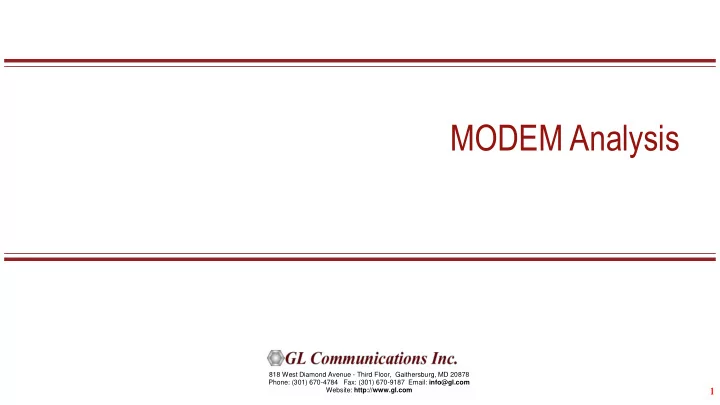

MODEM Analysis 818 West Diamond Avenue - Third Floor, Gaithersburg, MD 20878 Phone: (301) 670-4784 Fax: (301) 670-9187 Email: info@gl.com Website: http://www.gl.com 1 1
What are they ? Short for modulator-demodulator. A modem is a device or program that enables a computer to transmit data over, for example, telephone or cable lines. Computer information is stored digitally, whereas information transmitted over telephone lines is transmitted in the form of analog waves. A modem converts between these two forms. 2
Modem Characteristics distinguishing Modems Following characteristics distinguish one modem from another: bps : How fast the modem can transmit and receive data. ➢ At slow rates, modems are measured in terms of baud rates. The slowest rate is 300 baud (about 25 cps). At higher speeds, modems are measured in terms of bits per second (bps). The fastest modems run at 57,600 bps, although they can achieve even higher data transfer rates by compressing the data. voice/data: ➢ Many modems support a switch to change between voice and data modes. In data mode, the modem acts like a regular modem. In voice mode, the modem acts like a regular telephone. data compression : ➢ Some modems perform data compression, which enables them to send data at faster rates. However, the modem at the receiving end must be able to decompress the data using the same compression technique. 3
Two Types of Modems 4
Two Types of Modems… 5
Cable Modem A cable modem is a network bridge that conforms to IEEE 802.1D for Ethernet networking (with some modifications). The cable modem bridges Ethernet frames between a customer LAN and the coax cable network. 6
Asymmetric Digital Subscriber Line (ADSL) 7
Modem Communication Phases Phase 1 Network Interaction Phase 2 Probing / Ranging Phase 3 Equalizer and Echo canceller training Phase 4 Final training 8
Phase 1 – Network interaction (as per V.8) 9
Phase 2 – Probing / Ranging 10
Phase 3- Equalizer and Echo Canceller Training 11
Phase 4 - Final training 12
GL’s Modem Decoding & Analysis Software - GLInsight ™ 13
GLInsight ™ Modem Analysis 14
GLInsight ™ Decoded Files V34_33600energy_ans_lo.pcm It is Answer modem detected signal power . V34_33600energy_org_lo.pcm Shows the level of the signal level dBm of the answer side and origin of the connection. The energy files are in dBm(/100) units. Value of -1900 represent - 19dBm.The energy files are generated only on V.34 and V.90 connections (lower data pump like v.32 and v.22 are not generating these files). V34_33600pdsnr_ans_lo.pcm Post Detection Signal to Noise Ratio) files should be opened as V34_33600pdsnr_org_lo.pcm 8000samples/sec, mono, 16 bit linear. Lo is low resolution (133.3 measurements per second) and Shows the value in dB (/100) of the Signal-to-Noise ratio of the answer side training data signal respectively. V34_33600raw_out_bits1.pcm This file contains the bits extracted by the data pump before the ECDC layer. It means for example that in start stop connection – the start and stop bits will be V34_33600raw_out_bits2.pcm found in this file V34_33600output_chars.bin This file contains the bits extracted after the ECDC layer in both directions in a PPPD format. V34_33600symbols1.pcm The symbols received by the originate modem and shows the four-point TRN V34_33600symbols2.pcm sequence (Phase 3), and the full constellation in the data stage (Phase 4). demodulated symbols in the 2-dimensional symbol space, received by the Originate modem 15
Spectrogram view of ECM_v17_14400_ans.pcm 16
Thank you ! 17
Recommend
More recommend